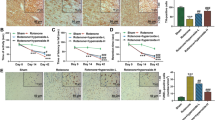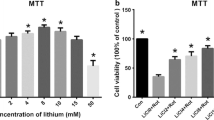Abstract
The detrimental impact on the food chain due to the overuse of rotenone is partly responsible for alpha-synuclein (α-syn) mediated neurotoxicity. It is hypothesized that rotenone overdose leads to cytosolic proteopathy resulting in modulation of apoptosis and autophagic pathways. The aim of our study is to explore the neuroprotective role of quercetin, a beneficial polyphenol against rotenone-induced neurotoxicity in dopaminergic human SH-SY5Y cell lines. In our study we demonstrated the correlation of rotenone-induced neurotoxicity through elevation of intracellular reactive oxygen species (ROS) and imbalance in the mitochondrial membrane potential (MMP). Moreover, the morphological distortion of cell, condensation of nuclei, externalization of the inner phosphatidylserine, cleavage of caspase 3, and Poly ADP Ribose Polymerase (PARP) confirmed apoptosis. However, all these lethal effects were ameliorated by treatment of quercetin to the cells. On the other hand rotenone has a strong effect on autophagy which is a regulated degrading and recycling cellular process to remove dysfunctional proteins. Indeed, rotenone-mediated autophagy resulted in the enhancement of autophagosome-bound microtubule-associated protein light chain-3 (LC3-II) expression. Furthermore, excess accumulation of acidic vesicles was detected in presence of rotenone. Lysosome associated membrane protein (LAMP-2A) is yet another crucial protein that recruits overexpressed or misfolded proteins into the lumen of lysosome to trigger autophagy. In all cases the impact of rotenone on the cells acquired significant protection through quercetin treatment. In the present work we therefore opine the prospects of quercetin as a therapeutic candidate against neurotoxicity.







Similar content being viewed by others
References
Tysnes O, Storstein A (2017) Epidemiology of Parkinson’s disease. J Neural Trans 124(8):901–905. https://doi.org/10.1007/s00702-017-1686-y
Goedert M, Eisenberg D, Crowther R (2017) Propagation of tau aggregates and neurodegeneration. Annu Rev Neurosci 40:189–210. https://doi.org/10.1146/annurev-neuro-072116-031153
Elbaz A, Dufouil C, Alpérovitch A (2007) Interaction between genes and environment in neurodegenerative diseases. C R Biol 330(4):318–328. https://doi.org/10.1016/j.crvi.2007.02.018
Yuan Y, Yan W, Sun J, Huang J, Mu Z, Chen N (2015) The molecular mechanism of rotenone-induced α-synuclein aggregation: emphasizing the role of the calcium/GSK3β pathway. TOXLET 8958:1–9. https://doi.org/10.1016/j.toxlet.2014.11.029
Samantaray S, Knaryan V, Guyton M, Matzelle D, Ray S, Banik N (2007) The parkinsonian neurotoxin rotenone activates calpain and caspase-3 leading to motoneuron degeneration in spinal cord of Lewis rats. Neuroscience 146(2):741–755
Sarkar S, Raymick J, Imam S (2016) Neuroprotective and therapeutic strategies against Parkinson’s disease: recent perspectives. Int J Mol Sci 17:904–935. https://doi.org/10.3390/ijms17060907
Moors T, Hoozemans J, Ingrassia A, Beccari T, Parnetti L, Chartier-Harlin M, van de Berg W (2017) Therapeutic potential of autophagy-enhancing agents in Parkinson’s disease. Mol Neurodegener 12(1):11
Martinez-Vicente M, Talloczy Z, Kaushik S, Massey A, Mazzulli J, Mosharov E, Hodara R, Fredenburg R, Wu D, Follenzi A, Dauer W, Przedborski S, Ischiropoulos H, Lansbury P, Sulzer D, Cuervo A (2008) Dopamine-modified α-synuclein blocks chaperone-mediated autophagy. J Clin Invest 118:777–788
Massi A, Bortolini O, Ragno D, Bernardi T, Tacchini S, Risi CD (2017) Research progress in the modification of quercetin leading to anticancer agents. Molecules 22:1270–1296
Mlcek J, Jurikova T, Skrovankova S, Sochor J (2016) Quercetin and its anti-allergic immune response. Molecules 21:622–636
Wang S, Yao J, Zhou B, Yang J, Chaudry MT, Wang MI, Xiao F, Yao L, Yin W (2018) Bacteriostatic effect of quercetin as an antibiotic alternative in vivo and its antibacterial mechanism in vitro. J Food Prot 81:68–78
Lee S, Lee HH, Shin YS, Kang H, Cho H (2017) The anti-HSV-1 effect of quercetin is dependent on the suppression of TLR-3 in Raw 264.7 cells. Arch Pharm Res 40(5):623–630. https://doi.org/10.1007/s12272-017-0898-x
Yao C, Xi C, Hu K, Gao W, Cai X, Qin J, Shiyun L, Canghao D, Wei Y (2018) Inhibition of enterovirus 71 replication and viral 3C protease by quercetin. Virol J 15:116–128. https://doi.org/10.1186/s12985-018-1023-6
Sadabady RR, Eidi A, Zarghami N, Barzegar A (2016) Intracellular ROS protection efficiency and free radical-scavenging activity of quercetin and quercetin-encapsulated liposomes. Artif Cells Nanomed Biotechnol 44:128–134
Yang T, Kong B, Gu JW, Kuang YQ, Cheng L, Yang WT, Xia X, Shu HF (2014) Anti-apoptotic and anti-oxidative roles of quercetin after traumatic brain Injury. Cell Mol Neurobiol 34(6):797–806
Yao L, Yao J, Han C, Yang J, Chaudhry MT, Wang S, Liu H, Yin Y (2016) Quercetin, inflammation and immunity. Nutrients 8(4):166–180
Chatterjee J, Langhnoja J, Pillai PP, Mustak MS (2019) Neuroprotective effect of quercetin against radiationinduced endoplasmic reticulum stress in neurons. J Biochem Mol Toxicol 33(2):1–8
Rakshit J, Mallick A, Roy S, Sarbajna A, Dutta M, Bandyopadhyay J (2020) Iron-induced apoptotic cell death and autophagy dysfunction in human neuroblastoma cell line SH-SY5Y. Biol Trace Elem Res 193(1):138–151. https://doi.org/10.1007/s12011-019-01679-6
Li N, Ragheb K, Lawler G, Sturgis J, Rajwa B, Melendez JA, Robinson JP (2003) Mitochondrial complex I inhibitor rotenone induces apoptosis through enhancing mitochondrial reactive oxygen species production. J Biol Chem 278(10):8516–8525. https://doi.org/10.1074/jbc.M210432200
Sun H, He X, Liu C, Li L, Zhou R, Jin T, Yue S, Feng D, Gong J, Sun J, Ji J, Xiang L (2017) Effect of oleracein E, a neuroprotective tetrahydroisoquinoline, on rotenone induced Parkinson’s Disease cell and animal models. ACS Chem Neurosci 8(1):155–164
Pouchieu C, Piel C, Carles C, Gruber A, Helmer C, Tual S, Marcotullio E, Lebailly P, Baldi I (2018) Pesticide use in agriculture and Parkinson’s disease in the AGRICAN cohort study. Int J Epidemiol 47(1):299–310
Chiaradia E, Renzone G, Scaloni A, Caputo M, Costanzi E, Gambelunghe A, Muzi G, Avellini L, Emiliani C, Buratta S (2019) Protein carbonylation in dopaminergic cells exposed to rotenone. Toxicol Lett 309:20–32
Datla KP, Zbarsky V, Rai D, Parkar S, Osakabe N, Aruoma OI, Dexter DT (2007) Short term supplementation with plant extracts rich in flavonoids protect nigrostriatal dopaminergic neurons in a rat model of Parkinson’s disease. J Am Coll Nutr 26(4):341–349. https://doi.org/10.1080/07315724.2007.10719621
Filomeni G, Graziani I, Zio DD, Dini L, Centonze D, Rotilio G, Ciriolo MR (2012) Neuroprotection of kaempferol by autophagy in models of rotenone-mediated acute toxicity: possible implications for Parkinson’s disease. Neurobiol Aging 33(4):765–785
Curro M, Bellocco E, Lentile R et al (2017) Neuroprotective effects of phloretin and its glycosylated derivative on rotenone-induced toxicity in human SH-SY5Y neuronal-like cells. Biofactors 43(4):549–557
Deng YN, Shi J, Liu J, Qu QM (2013) Celastrol protects human neuroblastoma SH-SY5Y cells from rotenone-induced injury through induction of autophagy. Neurochem Int 63(1):1–9
Kuang L, Cao X, Lu Z (2017) Baicalein protects against rotenone induced neurotoxicity through induction of autophagy. Biol Pharm Bull 40(9):1537–1543
Jang W, Kim HJ, Li H, Jo KD, Lee MK, Song SH, Yang HO (2014) 1,25-Dyhydroxyvitamin D3 attenuates rotenone-induced neurotoxicity in SH-SY5Y cells through induction of autophagy. Biochem Biophys Res Commun 451(1):142–148. https://doi.org/10.1016/j.bbrc.2014.07.081
Kang SY, Lee SB, Kim HJ, Kim HT, Yang HO, Jang W (2017) Autophagic modulation by rosuvastatin prevents rotenone-induced neurotoxicity in an in vitro model of Parkinson’s disease. Neurosci Lett 642:20–26
Kale A, Piskin Ö, Bas Y, Aydin BG, Can M, Elmas Ö, Büyükuysal Ç (2018) Neuroprotective effects of quercetin on radiation-induced brain injury in rats. J Radiat Res 59(4):404–410
Moreno L, Puerta E, Suárez S, Santos M, Ramirez MJ, Irache JM (2017) Effect of the oral the oral administration of nanoencapsulated quercetin on a mouse model of Alzheimer’s disease. Int J Pharm 517:50–57
Nieoczym D, Socała K, Raszewski G, Wlaź P (2014) Effect of quercetin and rutin in some acute seizure models in mice. Prog Neuropsychopharmacol Biol Psychiatry 54:50–57
Priyanga K, Vijayalakshmi K (2018) Effect of quercetin and hesperidin on rotenone induced SH-SY5Y cells. J Pharm Chem Biol Sci 5(4):429–436
Bournival J, Quessy P, Martinoli MG (2009) Protective effects of resveratrol and quercetin against MPP+ induced oxidative stress act by modulating markers of apoptotic death in dopaminergic neuron. Cell Mol Neurobiol 29:1169–1180
Bournival J, Plouffe M, Renaud J, Provencher C, Martinoli MG (2012) Quercetin and sesamin protect dopaminergic cells from MPP+-induced neuroinflammation in a microglial (N9)-neuronal (PC12) coculture system. Oxid Med Cell Longev 2012:921941
Ly JD, Grubb DR, Lawen A (2003) The mitochondrial membrane potential (∆Ψm) in apoptosis; an update. Apoptosis 8:115–128
Nemani VM, Lu W, Berge V, Nakamura K, Onoa B, Lee MK, Chaudhry FA, Nicoll RA, Edwards RH (2010) Increased expression of alpha synuclein reduces neurotransmitter release by inhibiting synaptic vesicle reclustering after endocytosis. Neuron 65(1):66–79
Senior SL, Ninkina N, Deacon R, Bannerman D, Buchman VL, Cragg SJ, Wade-Martins R (2008) Increased striatal dopamine release and hyperdopaminergic like behavior in mice lacking both alpha-synuclein and gamma-synuclein. Eur J Neurosci 27(4):947–957
Emamzadeh FN (2017) Role of apolipoproteins and α-synuclein in Parkinson’s disease. J Mol Neurosci 62(3–4):344–355. https://doi.org/10.1007/s12031-017-0942-9
Antonioli M, Rienzo D, Piacentini M, Fimia GM (2017) Emerging mechanism in initiating and terminating autophagy. Trends Biochem Sci 42(1):28–41
Cuervo AM, Wong E (2014) Chaperone-mediated autophagy: roles in disease and aging. Cell Res 24(1):92–104
Acknowledgements
JB sincerely acknowledges Maulana Abul Kalam Azad University of Technology, West Bengal (MAKAUT, WB) for laboratory and infrastructure facilities. SP gratefully thanks UGC (Grant No. F/17-164/2013/SA-1) and ICMR JRF (Grant No. 3/1/3/JRF-2013/HRD-10-40901) for providing fellowship. JC is further thankful to MAKAUT TEQIP program for providing fellowship. Furthermore the authors are grateful to Jyotirmoy Rakshit and Dr. Susmita Roy, Dept. of Biotechnology, MAKAUT,WB for their critical reviewing and valuable suggestions during the manuscript preparation. Thanks are also due to Aleepta Guha Ray and Dr. Arun Bandyopadhyay, Indian Institute of Chemical Biology (CSIR), Kolkata for extending their experimental support whenever required. The authors are also thankful to CRNN, University of Calcutta for flow cytometry facilities.
Author information
Authors and Affiliations
Corresponding author
Ethics declarations
Conflict of interest
The authors declare that they have no conflict of interest.
Additional information
Publisher's Note
Springer Nature remains neutral with regard to jurisdictional claims in published maps and institutional affiliations.
Rights and permissions
About this article
Cite this article
Pakrashi, S., Chakraborty, J. & Bandyopadhyay, J. Neuroprotective Role of Quercetin on Rotenone-Induced Toxicity in SH-SY5Y Cell Line Through Modulation of Apoptotic and Autophagic Pathways. Neurochem Res 45, 1962–1973 (2020). https://doi.org/10.1007/s11064-020-03061-8
Received:
Revised:
Accepted:
Published:
Issue Date:
DOI: https://doi.org/10.1007/s11064-020-03061-8




